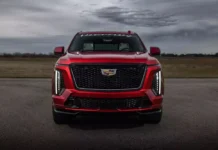The high-performance vehicles are always a dream of true car enthusiasts. And BMW, as the leading player in the automotive industry, has the mission to embody and convey that passion. Let’s review the memorable 40-year milestones of BMW M GmbH.
Part I: The Dawn
“A company is like a person. As long as it continues to be sporty, it remains full of enthusiasm and power.” Those were the words of Robert A. Lutz – a member of the BMW AG Management Board responsible for Sales in 1972 – for the youngest subsidiary of BMW AG at the time – BMW Motorsport GmbH. Nowadays, although renamed as BMW M GmbH, it is still vibrant, structured, full of enthusiasm and energy as it was 40 years ago.
The early 1970s were the dawn of a new era for BMW. A young and fresh Management Board under the leadership of Eberhard von Kuenheim set out an energy strategy and pursued continuous success for the company. This included the construction of a new headquarters – the famous Four-Cylinder Building – as well as the establishment of an in-house sports department. Robert A. Lutz’s quote once again, “Sports has always been the driving force at BMW.”
Indeed, the demand and untapped opportunities went far beyond the potential and capabilities of the previous sports department. The BMW 1800 TI and 2000 TI as well as the entire 2 Series only met a part of the overall demand, with most of the cars being prepared, operated and sold by tuning companies. Since the mid-1960s, BMW has also participated in the Formula 2 racing. And since then, no racing team has been able to join the Formula races successfully without the presence of high-performance BMW cars. BMW has won countless races in Europe and around the world.
1972: A seasoned racing team established BMW Motorsport GmbH
BMW Motorsport GmbH was born on May 1st, 1972. The team’s experienced racing team director with a total of 35 members was Jochen Neerpasch, a former ex-Porsche driver and Ford Racing manager in Cologne before moving to Munich. He immediately attracted a group of drivers: Chris Amon, Toine Hezemans, Hans-Joachim Stuck, and Dieter Quester. Björn Waldegaard and Achim Warmbold were recruited by the company as combined drivers.
The new company was able to move into the building within a few months with a racing workshop and a production equipment store – all located in the immediate vicinity adjacent to BMW’s Munich plant on an area of about 8,000 m2 on Preussenstrasse. This is where the sports cars for the year 1973 were manufactured: A 950kg 2002 with the power of a 2l engine, a 4-valve 4-cylinder engine with a maximum output of 240 horsepower for long-distance racing along with a touring coupe. In the early days, Jochen Neerpasch himself could not believe his team would win the European Championship in their first season.
The chosen car was the 3.0 CSL. The doors and lids were made of aluminum, and the 5-speed gearbox was equipped with magnesium coating. The total weight was 1092kg, but the real highlight was hidden under the hood, a 3340cc 6-cylinder inline engine with 12 valves, fuel injection with a compression ratio of 11:1 and a maximum output of 360 horsepower. It was the last 2-valve racing engine built by BMW.
BMW tradition philosophy: People focus
BMW Motorsport GmbH entered the 1973 season with perfect preparation not only in terms of technology. The drivers were also deserving, with the selection of Jochen Neerpasch for the entire lineup aimed at a driver tuning season in St. Moritz. Here, in the paradise of Swiss skiers, the entire team received guidance from a sports coach and a sports psychologist. Even afterwards, at the beginning of each year, BMW dedicated a great deal of work to optimizing human/machine interface. And even later, non-professional training courses were also provided. Since 1977, these courses have been called BMW driving training courses.
This is where the BMW Motorsport GmbH team raced in the 1973 season. And it was not only the 3.0CSL coupe that made an impact from the beginning: For the first time, there was a complete racing team, from the truck carrying the race cars to the key chains with the same design. There are three stripes of blue, purple, and red on a white background, the distinctive appearance of BMW Motorsport until today.
The CSL coupe in these colors quickly became internationally known as an unbeatable racing car. Hans-Joachim and Chris Amon brought home the Touring Car Grand Prix award at the Nürburgring on their first effort. BMW won the overall victory of the Touring Car Category at the 24 Hour Race in Le Mans.
Successful touring car – BMW 3.0 CSL
The iconic 3-color legendary 3.0 CSL coupe then became the most successful touring car of its time, with 6 wins in the European Championship from 1973 – 1979 and dominating the touring car scene for nearly a decade. The BMW 3.0CSL was a pioneering not only in color design but also through a range of important technical innovations.
Firstly, it was powered by the first 6-cylinder 4-valve engine by BMW. Secondly, it was equipped with the first prototype of an anti-lock braking system from 1974, long before this innovation became a technical standard on the BMW 7 Series. And finally, within the shell of this high-speed coupe, the 3.0 CSL develops maximum power up to 800 horsepower. In 1976, BMW Motorsport GmbH sent BMW’s most powerful touring car to the race with Ronnie Peterson, this highest version of BMW equipped with a 3.2l turbocharged engine still deliberately reduced performance to 750 horsepower.
BMW Motorsport GmbH continued its successful development in Formula 2: 50 cars equipped with BMW’s 2-liter 4-valve engine hit the road, resulting in 11 wins in 16 races. In 1973, Jean Pierre Jarier with a BMW won the European Formula 2 championship and this engine continuously dominated the 2-liter engine category for nearly ten years with Patrick Depailler (1974), Bruno Giacomelli (1978), Marc Surer (1979), and Corrado Fabi (1982) winning this category with BMW-powered racing cars. Other teams were stunned by the 2-liter 4-cylinder engine produced in a factory more than 500 of which mostly developed over 300 horsepower.
In 1975, BMW Motorsport GmbH transferred its focus to the other side of the Atlantic. At that time, it focused on the IMSA Series, looking during the process at introducing the BMW brand to a wider market – the United States. At the end of the year, the number of Americans who knew BMW as an abbreviation for “Bavarian Motor Works” significantly increased and it was no surprise that BMW won the manufacturer category at the IMSA championship.
1976: Driving school becomes BMW driving training courses
On February 3rd, 1976, the BMW AG Management Board decided to entrust BMW Motorsport GmbH with another task: professionalizing the activities that were still called “driving school” at the time. Responsible for all BMW sports activities, BMW Motorsport GmbH wanted to promote its driving skills as part of the human/machine system.
From the start, one of the main tasks of BMW driving training courses was to provide cars for participants to use, and this philosophy has not changed to this day. This means that all participants have similar cars in terms of technical condition. In order to implement this philosophy in practice, the company set up a small BMW 320i car fleet. All of these cars were equipped with a special adjustable suspension system, limited-slip differential with a locking effect of 40%, and one-seat for the driver. Therefore, the BMW driving training courses’ first lineup was well-prepared.
The BMW driving training courses’ program was established in its entirety and ready for the first courses at the Manching military airport near Ingolstadt. Rauno Aaltonen officially joined as the first BMW technical director on January 13th, 1977. In fact, Aaltonen applied his experience not only on the race track but also through books on driving published at the time: “Revolution at the Wheel” – a unique book describing the course and program, so it was sold out in an instant. To this day, this book continues to convey Aaltanen’s unique skills to BMW drivers, although today the focus for a long time has been put on better safety.
The first appearance of a BMW road-going
Also in the late 1970s, BMW Motorsport GmbH focused almost entirely on building race cars. However, the fact that not only the racers but also car enthusiasts in daily life were looking for M Power pushed the “hot” 5 series into production starting from 1974: 530, 533i, 535i. Indeed, these cars were superior to their counterparts not only in terms of the engine but also in terms of suspension and brake technology – they became a revolution in high-performance 4-door cars in the sports car world. Initially, these cars were produced and released with very small quantities, but soon the performance philosophy became increasingly popular. Before 1980, 895 cars based on the first-generation 5 series were sold.
>> Part II: The shining star in the sports car world
Ngọc Điệp (TTTĐ)












































